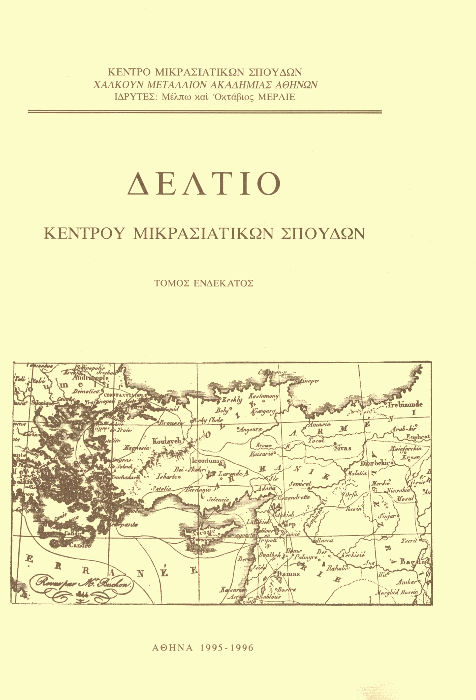Η σπασμωδική συγκριτική γραμματολογία του νέου ελληνισμού και η "Γραικοτουρκική" διασκευή του πολυπαθούς του Γρ.Παλαιολόγου
Περίληψη
The article deals with some aspects of the 19th c. fortunes of the Modem Greek
picaresque novel Ό Πολύπαθης (The Much-Suffering/The Much-Tried, Athens
1839). Written by Gregorios Palaiologos, a Greek born in Constantinople and
active particularly in France and the Greek State, the novel gained its justified
fame especially through its four-volume «Greco-Turkish» («karamanh»)
adaptation by Evangelinos Misaelides (Ταμασάϊ Δοννγιά βε Αζεφακιάρ-ον
Λζεφακές / Tamasa-i Diinya ve Cefakâr u Cefakes = The Spectacle of the World.
The Torturer and the Tortured, Constantinople 1871-2). The original Greek work
went almost unnoticed in Athens at the time and was only recently «rediscovered
» by Modern Greek editors and comparatists; yet Misaelides, a leading
figure in «Greco-Turkish» literature and a well-known translator, editor and
publisher in Smyrna and Constantinople managed to transform Palaiologos’
novel into an influential and very popular work that combines the technique of a
frame story with inserted anecdotes, apologues and a rich gamut of mythological,
historical, religious and ecclesiastical, and anthropological material.
Believed for a long time as being an original work, and the first Modern
Turkish novel as well, Temasa-î Diinya was repeatedly praised by turcologists,
reedited recently in Istanbul in the Moden Turkish (romanized) alphabet and
studied either as a piece revealing interesting linguistic features of the Ottoman
Turkish of the time or as an evidence of a pro-Ottoman literary movement
embraced by the Turkish-speacking Orthodox Christian élite supposedly fully
integrated into the Ottoman «tradition» and the so-called Ottoman polysystem.
The author points out a lot of misunderstandings and misconceptions and
discusses some prejudices both of Turkish and Greek scholars. In his opinion,
Misaelides’ profound knowledge of the ancient, medieval and Modem Greek
language and literary tradition, as well as his awareness of contemporary Western
European (mainly French) literary trends should not be questioned; in matters of
intertextuality, a much greater range of Modern Greek literary texts (including
the novelistic Apocrypha, from the mid 19th c. onwards) should be investigated as
an eventual parallel set of sources of this «Greco-Turkish» masterpiece.
Λεπτομέρειες άρθρου
- Πώς να δημιουργήσετε Αναφορές
-
Κεχαγιόγλου Γ. (1995). Η σπασμωδική συγκριτική γραμματολογία του νέου ελληνισμού και η "Γραικοτουρκική" διασκευή του πολυπαθούς του Γρ.Παλαιολόγου. Δελτίο Κέντρου Μικρασιατικών Σπουδών, 11, 125–133. https://doi.org/10.12681/deltiokms.52
- Τεύχος
- Τόμ. 11 (1995)
- Ενότητα
- Άρθρα

Αυτή η εργασία είναι αδειοδοτημένη υπό το CC Αναφορά Δημιουργού – Μη Εμπορική Χρήση – Παρόμοια Διανομή 4.0.
Οι συγγραφείς των άρθρων που δημοσιεύονται στο Δελτίο διατηρούν τα δικαιώματα πνευματικής ιδιοκτησίας επί των άρθρων τους, δίνοντας στο περιοδικό το δικαίωμα της πρώτης δημοσίευσης. Άρθρα που δημοσιεύονται στο Δελτίο διατίθενται με άδεια Creative Commons 4.0 και σύμφωνα με την άδεια μπορούν να χρησιμοποιούνται ελεύθερα, με αναφορά στο/στη συγγραφέα και στην πρώτη δημοσίευση για μη κερδοσκοπικούς σκοπούς και με δικαίωμα τροποποίησης μόνον με παρόμοια διανομή (αν αναμείξετε, τροποποιήσετε, ή δημιουργήσετε πάνω στο υλικό, πρέπει να διανείμετε τις δικές σας συνεισφορές υπό την ίδια άδεια όπως και το πρωτότυπο).



